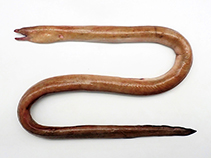| Family: |
Muraenidae (Moray eels), subfamily: Muraeninae |
| Max. size: |
400 cm TL (male/unsexed) |
| Environment: |
reef-associated; freshwater; brackish; marine; dH range: 15 - 30; depth range 0 - 15 m, amphidromous |
| Distribution: |
Indo-West Pacific: Red Sea and East Africa to the western Pacific. |
| Diagnosis: |
Vertebrae: 183-196. Brownish grey above, lighter below (Ref. 3257). Body moderately elongate, cylindrical in front, compressed along tail; eyes small; teeth small, biserial, inner series enlarged; head not obviously distinct from trunk although the profile is moderately steep; very large mouth, extending to well beyond eye; biserial sharp teeth on jaws, larger in front and in inner row; dorsal fin inserted on head before gill-opening; scales absent (Ref. 4832). |
| Biology: |
Inhabits muddy ocean bottoms (Ref. 6934) and estuarine areas (Ref. 2334), but sometimes found in rivers (Ref. 2334) and inner bays (Ref. 37816). Feeds mainly on a variety of small fishes and crustaceans. Known to extend itself vertically from a burrow with its head held horizontally beneath the surface, rising and falling with the tide (Ref. 9710). Marketed fresh and consumed locally (Ref. 3258). Solitary (Ref 90102). |
| IUCN Red List Status: |
Least Concern (LC); Date assessed: 13 November 2019 Ref. (130435)
|
| Threat to humans: |
traumatogenic |
Source and more info: www.fishbase.org. For personal, classroom, and other internal use only. Not for publication.
